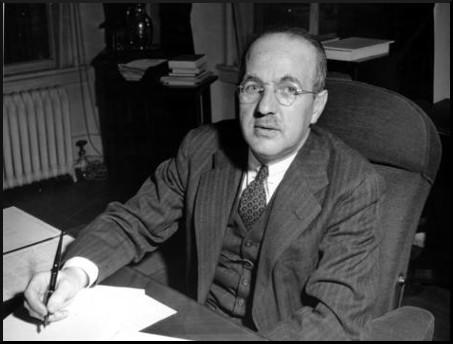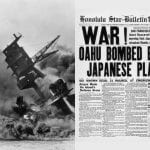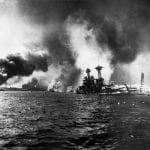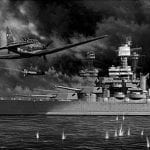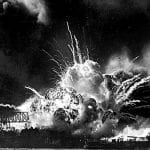The following is an excerpt from John Koster’s Operation Snow: How a Soviet Mole in FDR’s White House Triggered Pearl Harbor. Using recently declassified evidence from U.S. archives and newly translated sources from Japan and Russia, it presents new theories on the causes of the Pearl Harbor attack. It is available to order now at Amazon and Barnes & Noble.
Below is a list of the figures that figured into the historical incident of “Operation Snow”—an act of Soviety espionage that initiated a toppling of dominoes, utlimately leading to December 7, 1941.
Acheson, Dean. Attorney with the U.S. State Department who tightened the oil embargo on Japan beyond what FDR had intended while FDR was on vacation.
Akhmerov, Iskhak (“Bill”) Abdulovich. NKVD spymaster for the United States who controlled Soviet espionage and was the controller for Vitalii Pavlov.
Bentley, Elizabeth. “The Red Spy Queen,” a defector from Soviet intelligence who denounced Harry Dexter White as a Soviet agent of influence.
Berle, Adolf. Assistant secretary of state who, eighteen months before Pearl Harbor, passed a warning from Whittaker Chambers and Isaac Don Levine to FDR that Harry Dexter White was a Soviet agent. FDR dismissed the warning as nonsense.
Bykov, Boris. Soviet spymaster who served as the controller for Whittaker Chambers and later for Elizabeth Bentley, both of whom disliked him intensely.
Chambers, Whittaker. Soviet intelligence courier for Harry Dexter White. Chambers later defected and denounced White as a Soviet agent of influence. Chambers’s book Witness provided inside details of the Soviet intelligence network in the United States.
Chiang Kai-shek. Chinese Nationalist leader and America’s candidate for future control of China. He was defeated by Mao in 1949.
Christie, J. Walter. American automotive genius who designed and illegally shipped the prototype of the BT and T-34 tanks to the Soviet Union while the trade embargo was still in effect.
Currie, Lauchlin. Canadian-born economist identified by defectors as a Soviet agent in the FDR administration.
Durdin, Frank Tillman. New York Times correspondent who described the Japanese massacres at Nanking as factual but on a vastly smaller scale than reported in the West by historian Iris Chang.
Fish, Hamilton. Republican member of Congress from Dutchess County, New York (FDR’s home district), who opposed American entry into World War II before Pearl Harbor and urged action to save European Jews. Fish was an early advocate of Pearl Harbor conspiracy.
Fumiko Hayashi. Japanese “woman’s author” famous for her Bohemian lifestyle who reported Japanese atrocities during the China Incident.
Fumimaro Konoye. Japanese prince, diplomat, and prime minister on the eve of the Pearl Harbor attack. Roosevelt rejected his proposal for a last-minute face-to-face meeting to avert war.
Gardner, Meredith. U.S. code-breaker who deciphered the Soviet code revealing that the Soviet agent “Jurist” was Harry Dexter White.
Gaston, Herbert. Assistant secretary of the Treasury in charge of department security. Harry Dexter White used Gaston to approve the hiring of suspected communists in the Treasury Department.
Gillette, Guy. Democratic senator from Iowa who attempted to win a hearing for Kilsoo Haan’s warnings about an impending Japanese attack on Pearl Harbor.
Grew, Joseph C. U.S. ambassador to Japan and advocate of Japanese-U.S. friendship. Grew issued several warnings about worsening diplomatic relations and a probable attack against Pearl Harbor.
Haan, Kilsoo. Korean nationalist working in the United States who, relying on reports from Hawaii, tried to warn the U.S. government that an attack on Pearl Harbor was planned for the first weekend in December 1941.
Hideki Tojo. Japanese general and prime minister (1941–1944); hanged for war crimes, 1948.
Hiss, Alger. U.S. State Department lawyer active in Soviet espionage. Convicted of perjury in 1950 on the testimony of Whittaker Chambers and served four years in prison.
Hornbeck, Stanley K. State Department expert on China who hated Japan. Neither a communist nor a sympathizer, Hornbeck believed that all Asians, including the Japanese, were easily intimidated, and he encouraged a tough stance before Pearl Harbor.
Hull, Cordell. Secretary of state 1933–1944; opposed U.S. intervention in Sino-Japanese conflicts and in the early stages of World War II.
Ikki Kita. Japanese folk-Christian leader who inspired the young officers of the uprising of February 26, 1936.
Iwane Matsui. Commander of Japanese forces in the Second Sino-Japanese War. Hanged for war crimes in 1948, though his personal responsibility for the “Rape of Nanking” is disputed.
Kantaro Suzuki. Grand chamberlain of Japan who survived an assassination attempt in the February 26, 1936, uprising; later prime minister. Katz, Joseph. “First line” recruiter of Soviet agents in the United States.
Keisuke Okada. Japanese prime minister who narrowly escaped assassination in the February 26, 1936, uprising.
Kichisaburo Nomura. Japanese admiral, diplomat, and ambassador to the U.S. 1940–1942.
Kimmel, Husband E. Replaced Admiral James Richardson as commander in chief of the Pacific Fleet in February 1941. Removed from command after the attack on Pearl Harbor.
Knox, Frank. Secretary of the Navy at the time of Pearl Harbor. After ignoring warnings of a probable attack from Admiral Richardson, Admiral Kimmel, and Kilsoo Haan, Knox circulated unfounded rumors of wholesale Japanese-American espionage and sabotage as factors in the Pearl Harbor catastrophe.
Koki Hirota. Japanese working-class politician and diplomat (“the man in the ordinary suit”). As prime minister, he entered the Anti-Comintern Pact of alliances against the Soviet Union. Though hanged for war crimes in 1948, he is widely viewed as a scapegoat.
Levine, Isaac Don. Jewish anti-communist who tried to help Whittaker Chambers convince Assistant Secretary of State Adolf Berle that Harry Dexter White was a Soviet agent.
Makoto Saito. Japanese lord privy seal assassinated in the uprising of February 26, 1936.
Marshall, George. U.S. Army chief of staff 1939–1945; later secretary of defense and state.
Masaharu Homma. Japanese general who drove MacArthur from the Philippines in 1942. His execution for complicity in the Bataan Death March surprised American witnesses, who thought the evidence exculpated him.
Matsuo Kinoaki. Mysterious author of The Three-Power Alliance and the United States–Japanese War, variously described as a military intelligence officer and a publicist.
Mitchell, Jonathan. Speechwriter for Treasury Secretary Morgenthau who testified against Harry Dexter White before the House UnAmerican Activities Committee.
Morgenthau, Henry, Jr. Secretary of the Treasury 1934–1945, mentor of Harry Dexter White, and close friend of FDR.
Mundt, Karl. Republican congressman from South Dakota (and future senator) and member of the House Un-American Activities Committee who questioned Harry Dexter White in 1948.
Nobuaki Makino. Advisor to Hirohito who narrowly escaped being assassinated in the uprising of February 26, 1936.
Pal, Radhabinod. Indian jurist and member of the Tokyo war crimes tribunal who voted for acquittal on the grounds that the U.S. had provoked war with Japan.
Pavlov, Vitalii. Soviet NKVD operative in the United States who directed Harry Dexter White to foment hostilities between the U.S. and Japan.
Perlo, Victor. Communist economist who held Treasury Department and other government positions throughout the Roosevelt administration; alleged Soviet agent.
Popov, Dusko. Double agent for Nazi Germany and for Britain who offered the FBI detailed information about German interest in Pearl Harbor.
Poyntz, Juliet Stuart. American communist whose protest against Stalin’s mass murders probably provoked her murder in 1938. Her fate prompted Whittaker Chambers to abandon his role as a Soviet agent.
Richardson, James O. Commander in chief of the Pacific Fleet who was ordered to move the fleet to Pearl Harbor. He warned about the Navy’s lack of preparation for a Japanese attack and was relieved of command in February 1941.
Silvermaster, Nathan Gregory. Ringleader of Soviet agents (the Silvermaster group) in the Roosevelt administration.
Stark, Harold. Chief of U.S. Naval Operations at the time of Pearl Harbor.
Stimson, Henry. Secretary of war 1911–1913, 1940–1945; secretary of state 1929–1933; opposed the “Morgenthau Plan” for the de-industrialization of postwar Germany.
Stripling, Robert E. Chief investigator of the House Un-American Activities Committee at the time of Harry Dexter White’s appearance before the committee.
Thomas, J. Parnell. Chairman of the House Un-American Activities Committee when Harry Dexter White appeared before it.
Togo Tanaka. Japanese-American journalist who disputed Kilsoo Haan’s reports of subversive Japanese activities in the U.S. Not to be confused with Japanese foreign minister Shigenori Togo, or Gi’ichi Tanaka, Japanese prime minister.
Tsuyoshi Inukai. Prime minister of Japan, assassinated in 1932 by nationalist military officers.
Ullman, William L. Treasury and War Department official, delegate to Bretton Woods Conference, and photographer for the Silvermaster group of Soviet agents.
Yosuke Matsuoka. U.S.-educated Japanese foreign minister 1940–1941.
Zhukov, Georgi. Soviet general in the 1939 Nomonhan Incident in Mongolia.
This article is part of our larger selection of posts about the Pearl Harbor attack. To learn more, click here for our comprehensive guide to Pearl Harbor.
 |
 |
This article is from the book Operation Snow: How a Soviet Mole in FDR’s White House Triggered Pearl Harbor © 2012 by John Koster. Please use this data for any reference citations. To order this book, please visit its online sales page at Amazon or Barnes & Noble.
You can also buy the book by clicking on the buttons to the left.
Cite This Article
"Operation Snow: Cast of Characters" History on the Net© 2000-2024, Salem Media.
April 20, 2024 <https://www.historyonthenet.com/operation-snow-cast-of-characters>
More Citation Information.



